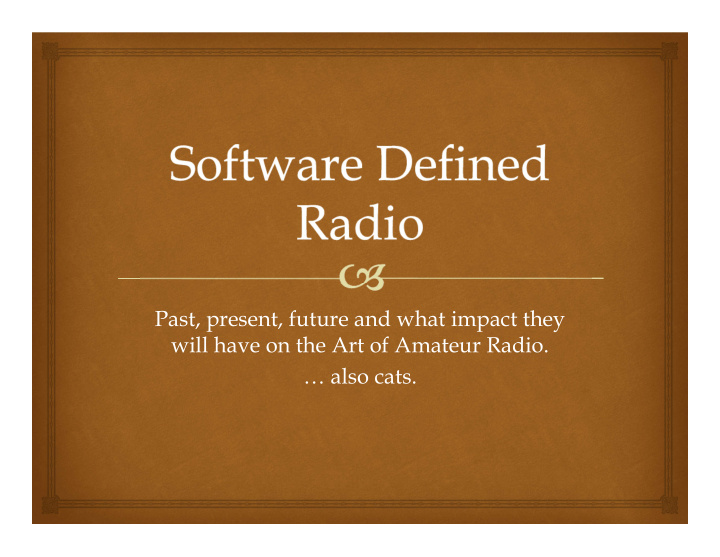



Past, present, future and what impact they will have on the Art of Amateur Radio. … also cats.
What is Software Defined Radio? Software-defined radio (SDR) is a radio communication system where components that have been typically implemented in hardware (e.g. mixers, filters, amplifiers, modulators/demodulators, detectors, etc.) are instead implemented by means of software on a personal computer or embedded system . In other words, you stick an antenna into your computer and QSOs come out.
Am I bothered? They’re not for everyone, but they are coming … ready or not. You are probably using one already They usually have more features for the same amount of cash or the same features for less cash.
Where did they come from? The term "software radio" was coined in 1984 by a team at the Garland, Texas Division of E- Systems Inc. (now Raytheon) Limited by the digital hardware at the time, these radios used extensive digital circuits to perform just a few functions.
What changed? Microprocessors got faster and cheaper. Gradually it became practical to perform the mathematical operations needed to filter and demodulate radio signals …
Wait ... Mathematical what now? A computer could, in theory, simulate all the voltages flowing through a radio circuit from the antenna to the speaker … In other words you could “build” a radio inside a computer. Drake 2B anyone? However, personal computers are not quite powerful enough, even now, to do that in real-time. We still rely on some circuitry to condition the signal into the audio frequency band before feeding it into the computer. The resulting wide band audio signals can be processed in real-time … and now we’re talking!
So, how does it work? Magic … right? Seriously though, I’m not going to get into the mathematics of real- time digital signal processing because I’d like you to stay awake for the next bit …
All right, so why are SDRs so “special”? Two reasons mainly 1. Accuracy - Electronic components are not perfect, filters can have steep sides … but never perfectly straight sides. 2. Flexibility – New modes, modulation schemes? No problem, just update the software!
My tax refund came and I NEED an SDR, what now? Want something plug and play? For the experimenter you Go Buy a FlexRadio … No, I’m can get a range of relatively serious … one weakness of SDR inexpensive kits, anywhere radios is that you rely on the software. You need to buy from a from $40 to as much as you company that has a chance of want to spend. being around for a while. Buy Perhaps even cheaper … from a small vendor and you risk being left with a radio that isn’t Certain TV receiving USB supported by the next version of dongles can be used to Windows. receive on 2M and up, also I don’t work for Flex, or even the HF bands with a own a Flex radio. However, I do own a kit SDR that is no longer converter. supported by Windows 10 Research, read & Google it Prices for FlexRadio transceivers range from $700 - $8500 … and also, ask around.
OK, I’m kidding (sort of). FlexRadio isn’t the only option There are a huge number of new transceivers available that are actually SDRs under the covers. The SDR Cube (left) is around $570 while the new Elecraft KX3 is more like $1000. Both use an internal embedded microprocessor. This negates the need for a separate computer at the price of a little less flexibility.
Tell me a tale of the future … Computers will get faster and cheaper. Devices being built will continue to move away from discrete circuits to “systems-on-a-chip” Existing brands, such as Yeasu, Kenwood, Icom and others are going to find themselves fighting for sales unless they innovate … quickly!
… and what would that look like? Its likely that analog to digital converters will be come fast enough and microprocessors will become powerful enough to process an entire ham band, or perhaps even the entire radio spectrum. Imagine a transceiver like this on a chip, integrated with a display and touch screen. Self contained for QRP operation and connected wirelessly or docked into an amplifier for QRO.
What could the SDR of the future do? Listen simultaneously to every digital mode on every ham band, looking for the call signs you want. Create real-time propagation maps by networking Amateur SDR receivers and logging the signal to noise ratio of every QSO as they happen. Dynamically adjust the bandwidth of your SSB signal, taking into account real-time band congestion. Cooperatively pick from a library of digital voice modes to find the best one for particular band conditions, on the fly.
What now? Amateur Radio led the forefront of technology for many years and I believe it still has an important part to play in determining the future of radio communication. Help to drive the development of new technologies by voting with your dollars, showing enthusiasm and discussing the possible uses of SDR with your brothers & sisters in the Amateur Radio community. Decide what the future will look like or it will be decided for you.
Thanks for watching! 73 KF5CZO
Recommend
More recommend